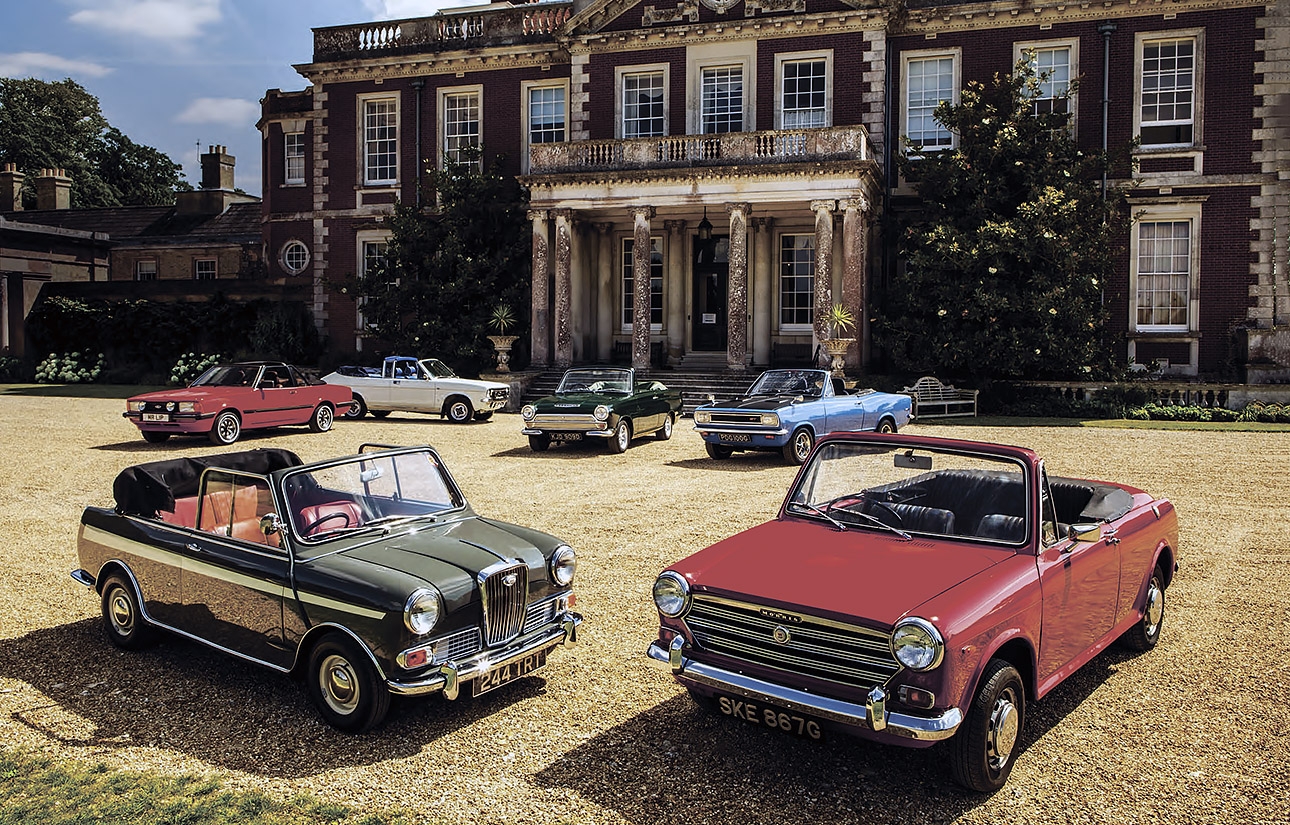
Going topless: humdrum saloons get sexy with a ragtop makeover The Kent-based coachbuilder gave dozens of mainstream models an alluring makeover, says Andrew Roberts as he samples six rare survivors. Photography Tony Baker.
Crayford’s Converts. In the Britain of the 1960s to the early ’80s, the term ‘Crayford convertible’ was as synonymous with summer as the BBC cricket commentary. After the 1950s, the UK motor industry began to abandon the open-topped four-seater tourer market and it was the Westerham firm, founded in 1962 by former Lambretta employees David McMullan and Jeffrey Smith, that brilliantly filled the vacuum. Crayford’s first conversions were of the Mini and, in tribute to its considerable achievements in producing softtop versions of monocoque family saloons, we’ve gathered the full spectrum of its offerings.
This sextet also demonstrates how Crayford’s skills made the familiar seem exotic, lending even a Morris Marina – a car not usually associated with the 1970s jet-set – a genuine sense of glamour. The fabric hood may have been an expensive option, but it gave a Vauxhall Viva or a Ford Cortina the allure of being a member of the coachbuilt elite. Plus, these charming dropheads were much easier to park outside Mac Fisheries than a James Young-bodied Bentley.
Viking Hornet Sport
Crayford’s Mini conversions also encompassed the Hornet, the greater length and neat fins arguably making for a more pleasing appearance. But the ‘Viking’ script on the Wolseley ghost light and the dynamic side flash on the Yukon Grey coachwork denote something much livelier. This was not a car for a primary school headmistress, but the perfect wheels for a raffish chap who favoured flat caps, a Graham Hill-style moustache and a cravat. The Hornet Sport, aimed at the Midget/Spitfire market, was devised by Viking Performance Cars of Suffolk.
‘IT WAS PERFECT FOR A RAFFISH CHAP WHO FAVOURED CAPS AND A GRAHAM HILL ’TACHE’
Unfortunately, Crayford built only a handful of Vikings before production ceased in 1964, which is a real shame. ‘Our’ car may have cost £200 more than a standard Hornet, but the hood – with its detachable side-screens – is extremely well crafted. The specification included an uprated exhaust, a remote-control gearchange and a rev counter perched on the steering column. There is also a driver’s seat that adjusts through ‘77 different positions’, and the Hornet is certainly more comfortable for the larger than average motorist than an Austin-Healey Sprite. Best of all, this is one of the most entertaining Minis ever made. The Sport equipment would originally have included a Taurus cylinder head – this was lost at some stage over the past 50 years – although the standard Hornet 998cc engine certainly feels potent enough.
There are minor foibles, both Mini related – those tiny pedals and the folded hood hampering rear visibility (there was nowhere for it to hide) – although neither of these issues detracts from the Viking’s character. It is a viable Cooper alternative that was far more versatile than any British light sports car of the early 1960s and is definitely in the pre-war Hornet Special tradition. And it boasts a Wolseley grille, which is always a social advantage on any vehicle.
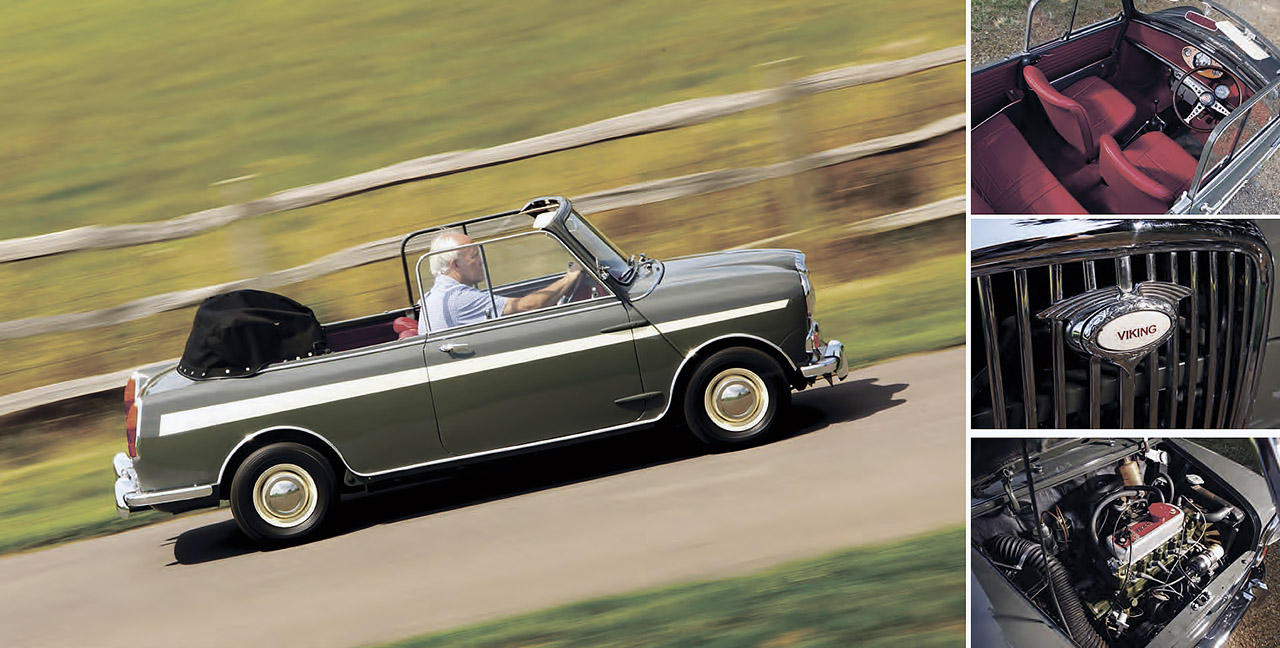
Inset: later Heinz 57 cars retained side windows. Below: high spec included sports wheel; famed ghost light; tuned A-series made it as quick as a Cooper.
VIKING HORNET SPORT
Sold/number built 1963-’64/six
Construction steel monocoque
Engine all-iron, ohv 998cc ‘four’
Max power 38bhp @ 5250rpm
Max torque 52lb ft @ 2700rpm
Transmission four-speed manual, driving front wheels
Suspension independent all round, at front by double wishbones rear trailing arms; rubber cone springs, Armstrong telescopic dampers f/r
Steering rack and pinion
Brakes drums all round
Length 10ft 10 ¼ in (3308mm)
Width 4ft 7 ½ in (1410mm)
Height 4ft 5in (1346mm)
Wheelbase 6ft 8in (2032mm)
Weight 1393lb (632kg)
0-60mph 17.3 secs Top speed 84mph
Price new £756 Now £20,000
Thanks to Bob Bridger, owner of the Viking Hornet and the Cortina opposite.
Ford Cortina Mk1 GT
If the soft-top Corsair featured in the December 2013 issue looked dashingly handsome in a transatlantic vein, then a Mk1 Cortina Crayford is its equal in aesthetic charm. Roy Brown’s superbly resolved styling, with its flattened fins and distinctive rear lights, lends itself well to the convertible treatment. With the top lowered, the GT even manages to convey a sense of the Hollywood road movie as we buzz along the roads of East Hampshire. Only the right-hand-drive steering and the familiar tappety engine note remind us that this is a drophead from Dagenham rather than Detroit.
Crayford made its first Cortina Convertible in early 1964 using the De Luxe, Super or GT as a base – there appear to be no official soft-top Mk1 Lotus Cortinas. A GT drophead cost about as much as an Austin-Healey 3000, but the Cortina was perfectly timed as a sporting four- or fiveseater with an innate appeal to a former TR4 or Alpine owner who had family commitments.
The Sunbeam Rapier Convertible had ceased production in 1963 and the Triumph Vitesse was cheaper but far more compact, so the Cortina Crayford proved such a success for the Westerham firm that it laid the foundations for 20 years of such Ford conversions. One of its most idiosyncratic export orders, for 30 Mk1 Cortinas, came from Bermuda where they served as hire cars and, bizarrely, taxi-cabs.
The hood mechanism may pinch some cabin space, but the rear seat is still able to accommodate two adults and there is enough room in the boot for a week’s luggage. The GT’s blend of respectable performance, easy road manners and practicality remains beguiling. It is difficult to imagine why anyone would want to spend an extra £140 on a Corsair unless for reasons of rank snobbery, because the original Cortina has Stateside glitz to spare – albeit Dagenham style.
‘THE GT EVEN MANAGES TO CONVEY A SENSE OF THE HOLLYWOOD ROAD MOVIE IN HAMPSHIRE‘
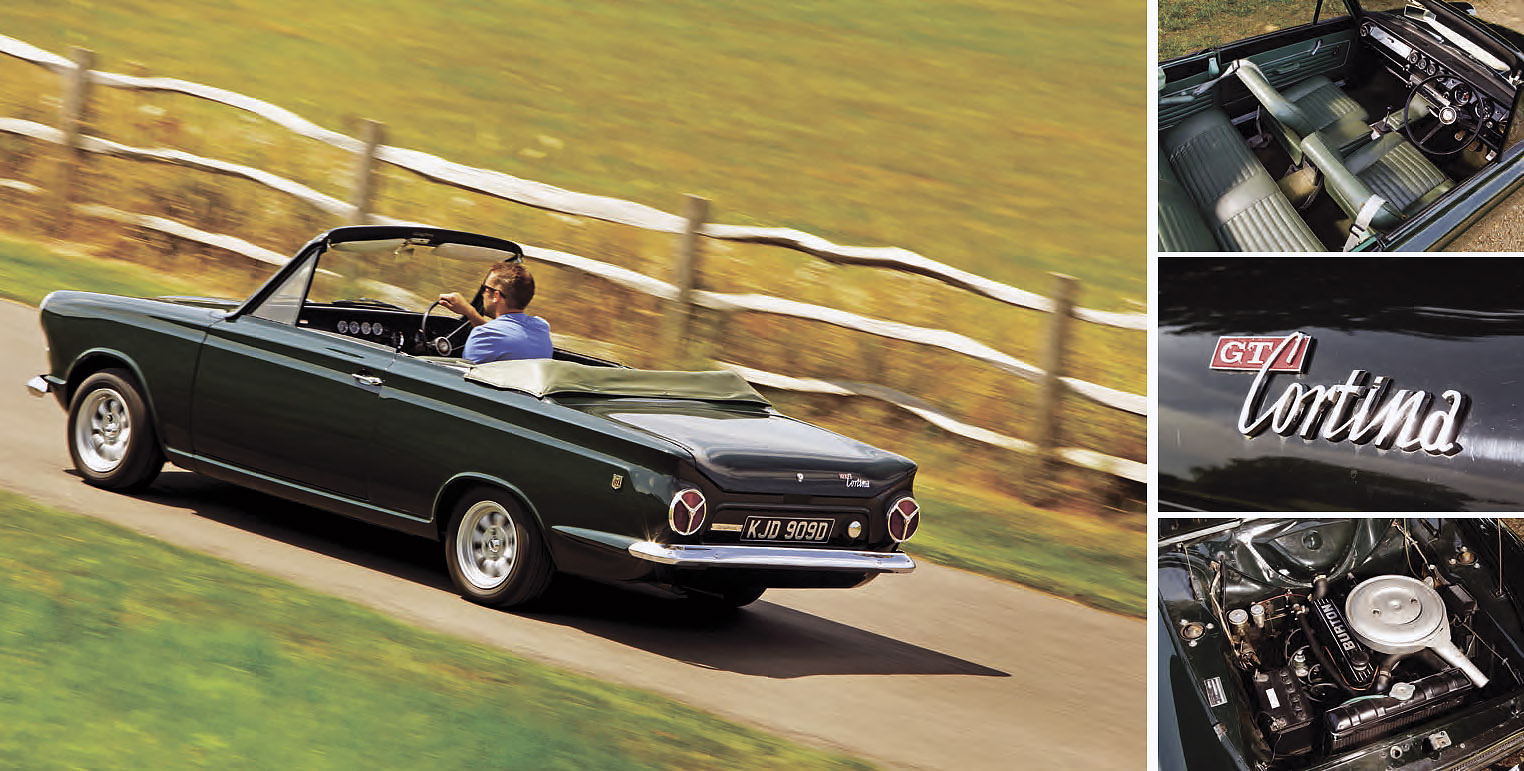
Inset: debut at Olympia Racing Car Show in 1964. Below: spacious cabin, with room for four; lots of dials on GT dash; this car sports a Burton engine.
FORD CORTINA Mk1 GT
Sold/number built 1964-’65/42
Construction steel monocoque
Engine all-iron, ohv 1498cc ‘four’
Max power 78bhp @ 5200rpm
Max torque 97lb ft @ 3600rpm
Transmission four-speed manual, driving rear wheels
Suspension: front independent, by MacPherson struts rear live axle with semi-elliptic leaf springs, Armstrong telescopic dampers.
Steering recirculating ball
Brakes discs front/drums rear
Length 14ft 1in (4293mm)
Width 5ft 3in (1600mm)
Height 4ft 9in (1448mm)
Wheelbase 8ft 2in (2489mm)
Weight 1750lb (794kg)
0-60mph 14 secs
Top speed 95mph
Price new £1024
Now £15,000
Vauxhall Viva GT
The advert for the GT drophead kicked off with a saucy: ‘Sensation! Viva goes topless!’ and it is indeed a stunning car. There will always be debate as to which is the best-looking Crayford, but, because the ‘Coke-bottle’ Viva HB was one of the most handsome small cars of its era, a well-executed conversion enhanced its appeal. A Le Mans Blue GT would have been the ideal vehicle for arriving at a swinging night spot, the roof lowered so admirers could bask in your general grooviness.
The Crayford Viva made its debut in early 1968, boasting a stylish mohair top – with elaborate lining – made by Karl Deutsch of Cologne. The GT was also introduced in 1968, its sporty credentials confirmed by the matt-black bonnet and extra instruments. Its 2-litre engine was the best able to cope with the extra weight of the conversion and the result is highly attractive.
The top can be lowered with one hand and as Guy Turner, the owner of this car, the former press demonstrator, points out: “It’s more of a cabriolet than a convertible; the hood is designed to be hidden when folded.” This was inevitably achieved at some sacrifice to rear-seat accommodation, but the GT still has enough space for, as the advert puts it, ‘fast moving foursomes’. It is a very pleasant cruising car, with a smooth torquey engine that belies its boy-racer image.
Possibly the only real British alternative to the Viva was the cheaper and slightly less exuberant Triumph Vitesse 2-litre Convertible.
Just seven Viva soft-tops are known to survive, five of which are SL90s – the most popular donor. It was pricey (a near-£300 premium), rainwater was prone to entering the body behind the B-pillar and the strengthening bars blocked the drain holes. Yet, as an exercise in turning the humble Viva into a four-cylinder British take on a Buick Skylark, it was utterly successful.
‘IT IS A VERY PLEASANT CRUISING CAR, WITH A SMOOTH ENGINE THAT BELIES ITS RACY IMAGE’
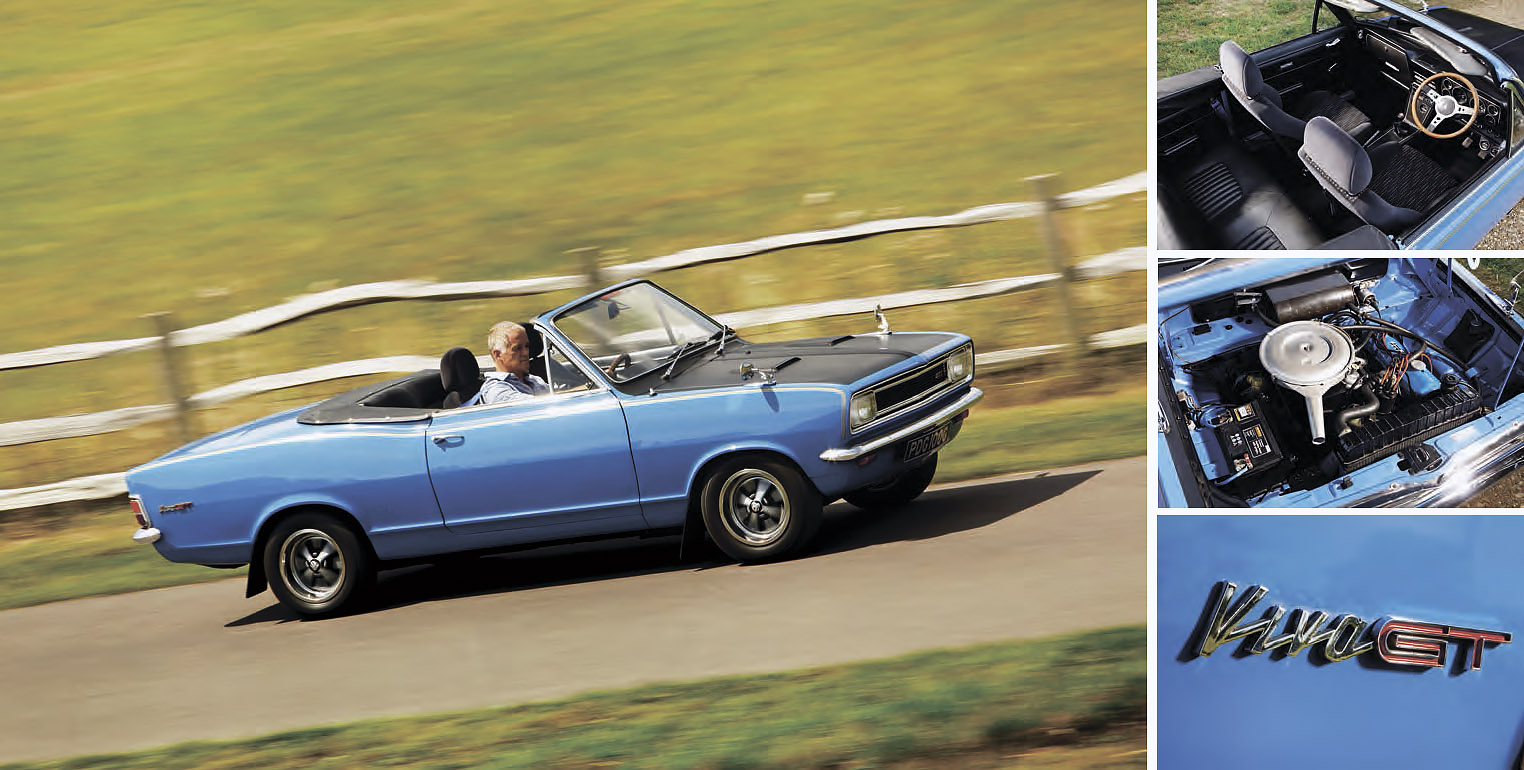
Inset: Wallace Arnold was sole agent for the Viva. Below: hood folds neatly but steals some rear-seat space; twin Strombergs on GT’s 2-litre ‘slant-four’.
VAUXHALL VIVA GT
Sold/number built 1968-’70/approx 12
(including one Brabham)
Construction steel monocoque
Engine all-iron, sohc 1975cc ‘four’
Max power 104bhp @ 5600rpm
Max torque 117lb ft @ 3400rpm
Transmission four-speed manual, driving rear wheels
Suspension: front independent, by double wishbones rear live axle, radius arms; coil springs, telescopic dampers f/r.
Steering rack and pinion
Brakes discs front/drums rear
Length 13ft 6in (4115mm)
Width 5ft 3in (1600mm)
Height 4ft 6in (1372mm)
Wheelbase 7ft 11in (2413mm)
Weight 2400lb (1088kg)
0-60mph 10.7 secs
Top speed 102mph
Price new £1342 Now £15,000
Thanks to owner Guy Turner
Morris 1300
The Morris 1300 provides a truly surreal experience for British motorists of a certain age. The dashboard, with its narrow strip speedometer, the ‘bus driver’ steering-wheel angle and the A-series engine note are all familiar from countless school runs and quite a few Public Information films. But this is the ADO16 less as family car and more as an elegant tourer. The combination of the famed dynamic abilities of the 1100/1300 range and fresh-air motoring remains immensely captivating.
A convertible version of the best-selling BMC car could not be contemplated until the twodoor MkII model was available in the UK in 1967. Crayford was not the first to construct a soft-top version – that honour went to Jensen, with a one-off based on an 1100 Countryman – but its chop, officially launched in February 1969, is highly accomplished. A hood could be fitted to new factory two-door Morris and MG 1300 saloons, Crayford strengthening the sills and window-winding mechanism to compensate for the lack of door pillars.
‘THE 1300 COULD HAVE SUCCEEDED THE MINOR TOURER, BUT IT COST AS MUCH AS A ROVER 2000’
The black-and-white period photo does not really convey just how well balanced the 1300 Convertible appears in the metal when the hood is lowered – practical but still slightly racy. The carefully designed top does not intrude on rearseat space, although it does occupy much of the boot. On a hot day, the car’s charms are obvious.
The 1300 drophead was introduced at about the same time as the last Morris Minor Tourers were leaving Cowley. It might have provided an ideal successor to the Moggie, but it cost as much as a Rover 2000 even before contemplating such extras as metallic paint or a beige top. Yet Crayford’s work is so thoroughly engineered – on a car that remains criminally underrated – that you might agree that the Morris was worth it.
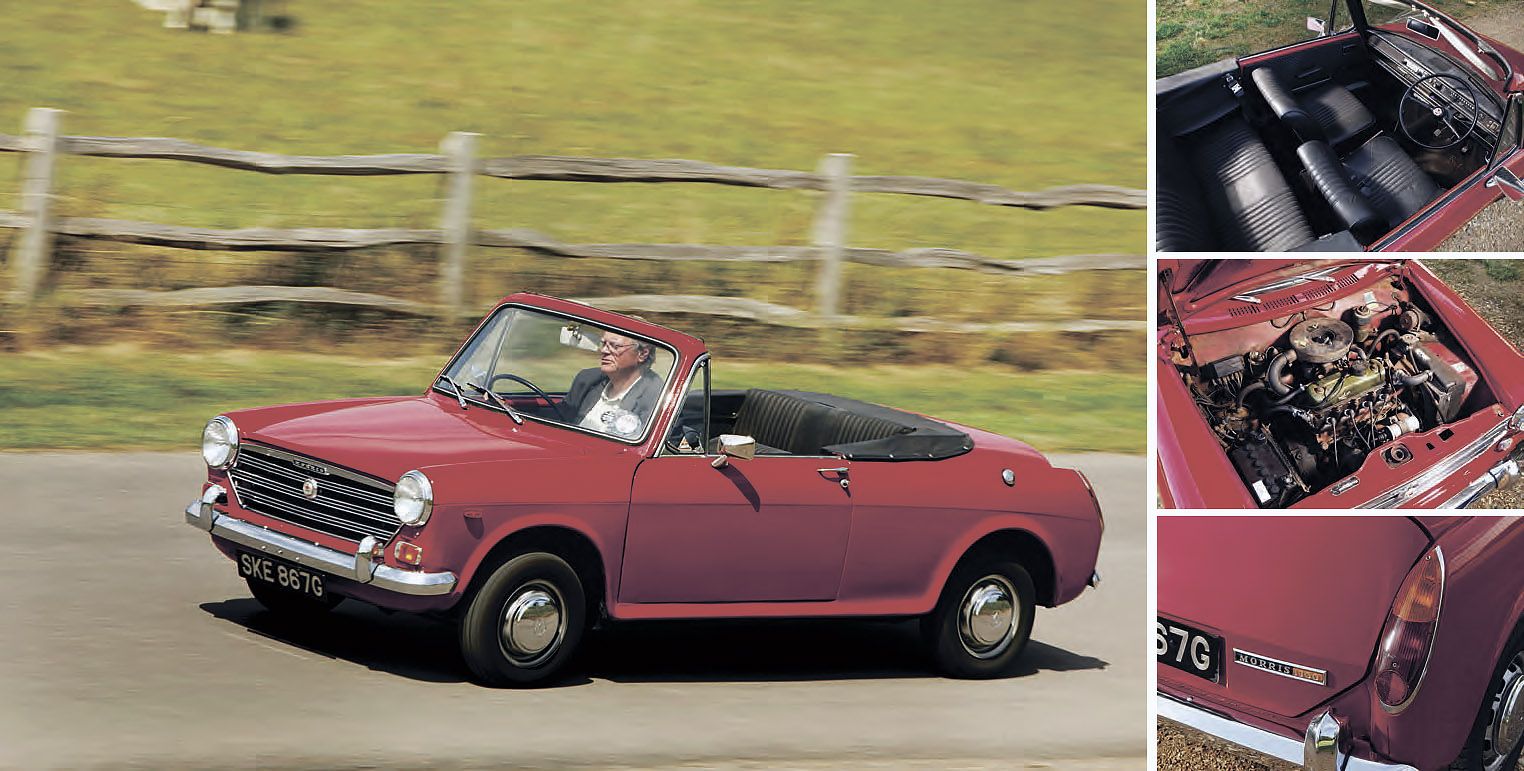
1300’s hood folds out of sight – mostly into the boot – so there’s plenty of room in cabin; signature PF light cluster; A-series feels reasonably lively.
MORRIS 1300
Sold/number built 12
(including one MG 1300)
Construction steel monocoque
Engine all-iron, ohv 1275cc ‘four’
Max power 60bhp @ 5250rpm
Max torque 60lb ft @ 2500rpm
Transmission four-speed manual, driving front wheels
Suspension independent all round, at front by double wishbones rear trailing arms; Hydrolastic displacers f/r
Steering rack and pinion
Brakes discs front/drums rear
Length 12ft 3in (3734mm)
Width 5ft (1524mm)
Height 4ft 5in (1346mm)
Wheelbase 7ft 9 ½ in (2375mm)
Weight 1852lb (840kg)
0-60mph 23.6 secs
Top speed 87mph
Price new £1519 10d Now £10,000
Thanks to owner Rory Cronin
Morris Marina 1.8TC
The very name ‘Mumford Marina’ conjures images not so much of endless sunshine but of warehousemen in brown shop coats, although this is slightly unfair. It remains a brave, if quixotic, attempt to turn what was a British Leyland stopgap model into an attractive open-top four-seater and it is testament to the fabricator’s art that it nearly succeeded. Crayford built the original Marina Convertible but thereafter the work was contracted to Plymouth-based coachbuilder Mumford, which was already well known for its camper vans. The vast majority were based on the 1.8TC and production ceased in 1976. About a dozen are believed to have survived, making this particular Marina as exclusive as your average Bugatti – if not more so.
One challenge facing anyone planning a Marina drophead was that it was one of the few cars where the saloon is better looking than the Coupé. Both versions used the same front doors, so there was an exaggerated rear side window on the two-door. This was lost in the convertible version so, to compensate, Crayford fitted a glass pane directly behind the B-pillar. The addition looks slightly awkward, however – especially around the tail – even if a window in the top of the roll-hoop is definitely an off-beat touch. And with the hood raised, the rear blind spots were even worse than on the standard Marina Coupé.
Even so, the Mumford is a clever and well-executed conversion, with a top that is easy to lower and a full-width back seat. The hood sits on the body when folded rather than dropping out of sight, so the result may not have been as conventionally handsome as Crayford’s Cortina MkIII conversion. But, as long as a keen motorist accepts all of the early Marina quirks – especially when negotiating a roundabout – this particular TC is as prime and as cherishable an example of 1970s kitsch as a fondue set.
‘IT REMAINS A BRAVE ATTEMPTTO TURN A BL STOPGAP INTO AN ATTRACTIVE TOURER’
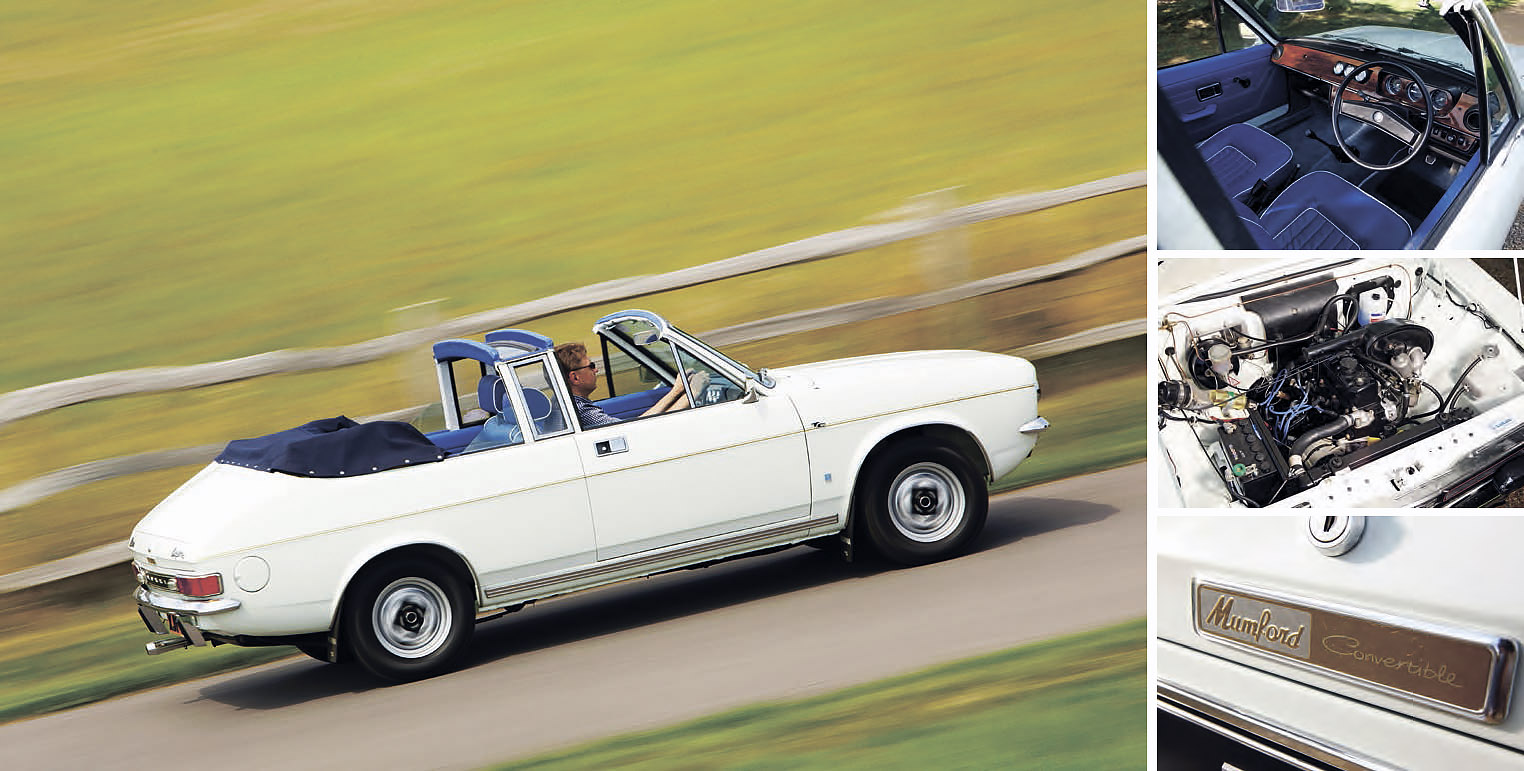
Inset: University Motors ad for ‘Topless Marina’. Below: quirky hoop makes up for loss of Coupé’s rear side window; plush interior; twin-carb unit pulls well.
MORRIS MARINA 1.8TC
Sold/number built 1973-’76/approx 70
Construction steel monocoque
Engine all-iron, ohv 1798cc ‘four’
Max power 95bhp @ 5250rpm
Max torque 106lb ft @ 2600rpm
Transmission four-speed manual, driving rear wheels
Suspension: front independent, by torsion bars, lever-arm dampers rear live axle, semi-elliptic leaf springs, telescopic dampers.
Steering rack and pinion
Brakes discs front/drums rear
Length 13ft 7in (4140mm)
Width 5ft 5in (1651mm)
Height 4ft 7in (1397mm)
Wheelbase 8ft (2438mm)
Weight 1994lb (904kg)
0-60mph 12 secs
Top speed 100mph
Price new £2156 Now £15,000
Thanks to owner Glen Andrews
Ford Cortina MkV
The MkV Cortina marked Crayford’s swansong for its car conversions before it concentrated on all-terrain vehicles. The rights to the Drophead Coupé were sold to Carbodies, which wanted to diversify from its staple FX4 taxi, but the prohibitive price put the soft-top Ford firmly in the Jaguar bracket.
The last Crayford Cortina was sold in 1.6, 2-litre and 2.3 V6 forms, but the featured example, the prototype, is based on the humble 1300. According to its proud owner Barry Priestman, chairman of the Crayford Convertible Car Club, only the 1.3-litre version made by Ford of Belgium was officially sold in the UK when the Westerham firm was evaluating a soft-top Mk5. Once Crayford had carried out its work, the 1300 gained full Ministry of Transport Type Approval and this could be applied to the largerengined models sold via Bristol Street Motors.
Priestman’s “unique and underpowered!” MkV was previously used by Carbodies’ MD and its squat, purposeful appearance is enhanced by the ‘T’ roll bar. As you bask in the midday heat, it makes you think less of Rothmans smoking and expense-claim fabrication in Little Chef car parks and more of endless holidays on the Côte d’Azur. Performance-wise it may be slightly restricted, although this does not prevent it from fulfilling the brochure’s promise of: ‘Wind in your hair. Sun in your face.’ This is the ideal car for cruising down the A303 to Yeovil, with your blazer buttons gleaming and barnet flying in the breeze as the Kent engine reassuringly chugs away. It’s an offbeat but highly convincing blend of early-1980s aggressive styling with 1950s-type Ealing comedy summer touring.
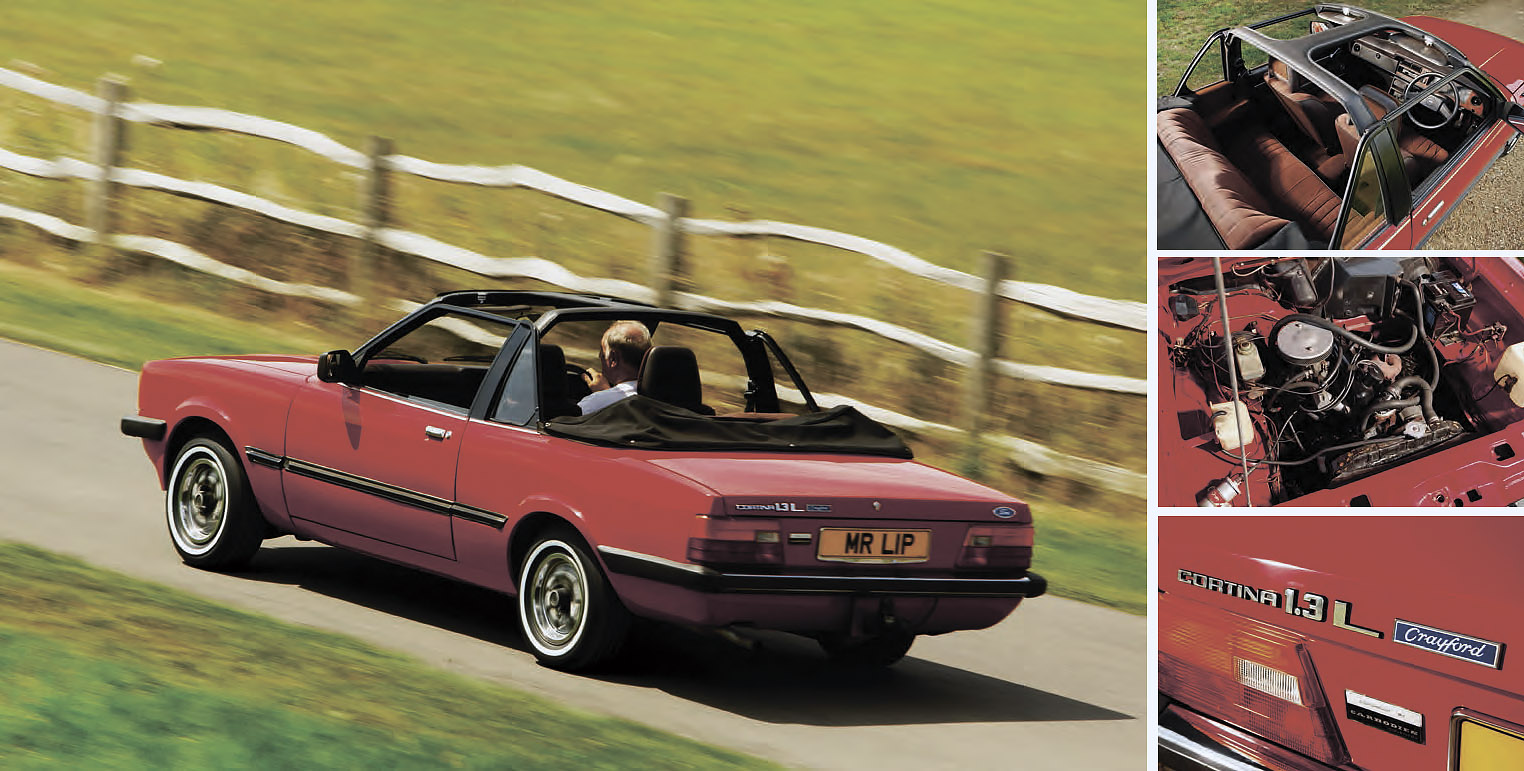
Inset: tongue-in-cheek ad emphasises its imageboosting potential. Below right: T-top adds rigidity; prototype’s 1300 Kent struggles in Cortina body.
FORD CORTINA MkV
Sold/number built 1980-’82/30-plus
Construction steel monocoque
Engine all-iron, ohv 1297cc ‘four’
Max power 60bhp @ 5750rpm
Max torque 67lb ft @ 5750rpm
Transmission four-speed manual, driving rear wheels
Suspension: front independent, by double wishbones rear live axle, semi-trailing arms; coil springs, telescopic dampers f/r
Steering rack and pinion
Brakes discs front/drums rear
Length 14ft 3in (4343mm)
Width 5ft 7in (1702mm)
Height 4ft 6in (1372mm)
Wheelbase 8ft 5 ½ in (2578mm)
Weight 2205lb (1000kg)
0-60mph 21 secs
Top speed 83mph
Price new c£8500 (1.3)
Now £10,000
Thanks to owner Barry Priestman; Crayford Convertible Car Club: www. crayfordconvertibleclub. com; Stansted Park: www. stanstedpark. co. uk
Conclusion
Even if you were obliged to drive one of our sextet in a Winter storm, you would still be dreaming of open-air motoring along the Riviera, or at least Bournemouth’s seafront. The convertibles represent just one aspect of Crayford’s work – it was a dab-hand with estates as well – but nothing can equal the brio of the Viva. ‘The joie de vivre of fresh air motoring,’ as the brochure promised.





